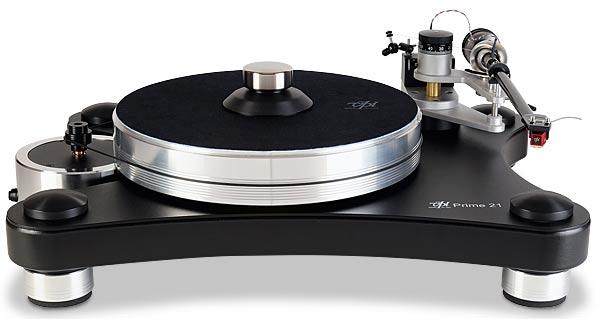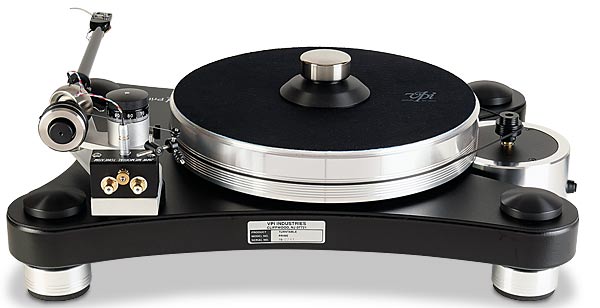VPI Prime 21+ Belt-driven Turntable

 A 2021 refresh of VPI's most popular turntable also sees a 'plus' option with bespoke moving-coil from Audio-Technica and RCA tonearm cable sourced from Nordost
A 2021 refresh of VPI's most popular turntable also sees a 'plus' option with bespoke moving-coil from Audio-Technica and RCA tonearm cable sourced from Nordost
By no means a newcomer to the audiophile LP-spinning scene – the brand is some 40 years young – VPI's recent range expansion has doubtless been further fuelled by the worldwide 'vinyl revival'. In addition to its diverse collection of tonearms, and innovative turntables including the direct-drive HW-40 Anniversary [HFN Apr '19], there are now two additions to VPI's 'Prime' series in the form of the Prime 21 and Prime 21+, priced at £4500 and £6500.
Both decks are now fitted with a gimbal-bearing tonearm, in place of the uni-pivot we saw in the original Prime [HFN Jun '15], while the '+' variant also includes an A-T built MC pick-up and custom RCA tonearm lead created for VPI by Nordost. More on these luxurious extras later, after we loop around the backstory…
VPI was founded by Harry and Sheila Weisfeld in Cliffwood, New Jersey, where it remains headquartered to this day, making all its products in the USA and sourcing materials from as close to home as possible. When Harry retired in 2013, his son Mat took over as president, and the original Prime turntable was his first design in this new role. The aim was to create a deck that remained true to the company's heritage but which would also benefit from Mat's fresh thinking.
Prime Numbers
So these new models are the latest to carry the Prime name – the '21' suffix denoting the year they were formally launched, even though both decks were first unveiled in 2020. On first acquaintance they don't look hugely different from the existing Prime turntable, but there are a number of key mods to be found under the skin. The main chassis is still made of MDF, but where the original had a steel plate attached to its underside, the Prime 21 and Prime 21+ feature a 3mm-thick aluminium plate bonded to the top for greater strength and, it is claimed, better control of resonances.
Meanwhile, a walnut finish is now available for the base in addition to the original black, and the feet used are the same as those found on the company's aforementioned HW-40 Anniversary model. These contain integral elastomer pads for isolation and are adjustable to assist in levelling the deck.

As in the original Prime, a single belt drives a 9kg aluminium platter, which is topped with a thick felt mat. Speed change from 33.3rpm to 45rpm is achieved by swapping the belt between steps on the motor pulley, while the belt itself sits in grooves around the platter's edge, eliminating any tendency for it to ride up and down. The motor pod has also been beefed up to further dampen unwanted vibrations, and this weighs in at 2.4kg, its shiny aluminium outer shell hiding improved internal motor circuitry.
Delight To Use
The pod sits to the left of the new design, although with no placement jig from VPI, it's left to the user to experiment and discover the location that offers optimum belt tension and speed stability.
The base for the new 10.5in arm is pre-fitted for ease of set-up. The arm itself makes use of the company's tried-and-trusted 3D printing technology for its tube, the uni-pivot bearing traded for a more conventional gimbal in response to feedback from customers. Nevertheless, this 'user-friendly' arm still features the same on-the-fly VTA adjustment found on its stablemates. It's a delight to use, even if some extra cue damping would help – the cueing lever can drop the stylus into the groove a tad abruptly if you're not careful!
A fine lead-out wire loops over to a connection box on the rear of the arm base, and although VPI suggests this can be twisted to fine-tune the anti-skating force this is hardly necessary as the arm also includes a perfectly serviceable – and adjustable – thread-and-lever bias mechanism. In addition to all of the above, the Prime 21+ also comes with a VPI Weisline interconnect cable made by Nordost, and a VPI Shyla cartridge (which is named after Mat's daughter).
The Shyla is built by Audio-Technica to VPI's specification and boasts a few specific modifications over the ART-9 series upon which it is based. VPI was keen to re-voice the MC's midrange, and this is realised in tweaks to the coils, the cantilever suspension and internal damping. The stylus is a line contact type, mounted on a 0.26mm-diameter boron cantilever.


















































